This website uses cookies so that we can provide you with the best user experience possible. Cookie information is stored in your browser and performs functions such as recognising you when you return to our website and helping our team to understand which sections of the website you find most interesting and useful.
db Making a Master: Maquis Gran Reserva Cabernet Sauvignon 2020
In the first of the drinks business’ new ‘Making a Master’ series, we look at Maquis winery and its Gran Reserva Cabernet Sauvignon 2020, which won a Master medal at the Global Cabernet Sauvignon Masters 2023.
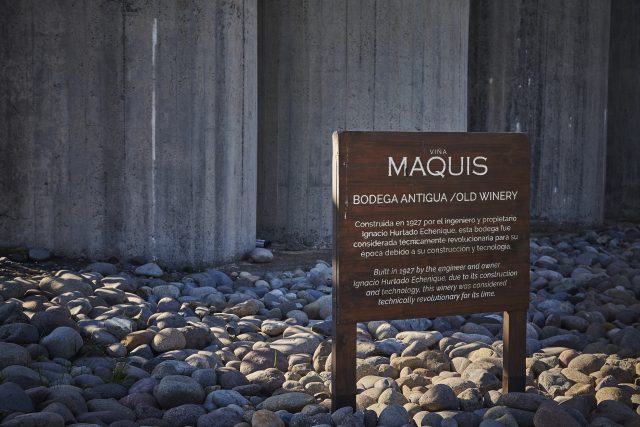
Maquis – the tradition
Of all the globally planted varieties of the world, Cabernet Sauvignon is the most reliable source of fine wine. Classed as the King of Grapes, it’s a variety that is able to yield outstanding results in a broad range of places. As long as there’s enough heat, and drainage – Cabernet likes dry gravelly soils – this grape can be the basis of wines that are wonderfully concentrated and structured, and, as a result, age-worthy.
Maquis Gran Reserva Cabernet Sauvignon is the perfect representative of the style – and of Maquis wines. It is produced as a 100% single-vineyard wine, grown solely on the Maquis Estate.
The Viña Maquis estate is located in the heart of the Colchagua Valley in central Chile, forming the south-western part of the larger Rapel Valley region. Some of the country’s best red wines are made in this valley, including Cabernet Sauvignon and Carménère.
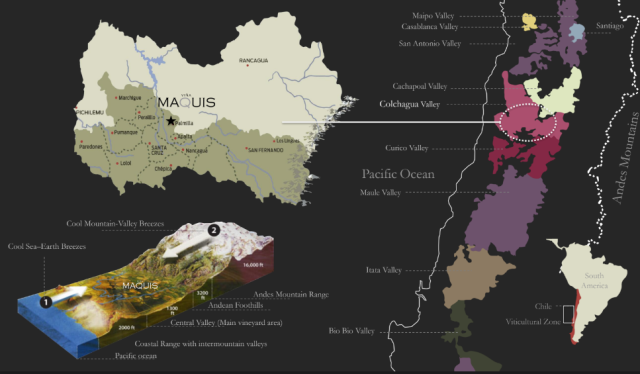
Maquis winery is the creation of the Hurtado family, starting its life in 1916. The family’s viticulture and winemaking has focused on searching for the freshest acidity and brightest fruit expression from this sunny pocket of the Colchagua Valley.
Its vineyard is uniquely located between two rivers, offering a natural dynamic element to its terroir, impacting its wines alongside the other parts of the climate. The two rivers provide frost protection in the winter months and a cooling effect in the summer. The end result is outstanding wines with floral notes.
Artisanal methods have been preserved in its winemaking process, and it has an award-winning sustainability approach, receiving in its early years the certification from Wines of Chile and a Britanic-Chilean Chamber award for energy-saving and carbon footprint reduction. It aims to produce balanced wines, in the pursuit of natural freshness with a moderate alcohol level. The wines have characteristic aromas that combine fresh fruit, floral and herbal notes with well integrated oak. Depending on the wine and vintage, they are aged in 225 litre French oak barrels for 12 to 24 months. It also undertakes early blending from its master blender Eric Boissenot, who decides on the blends two or three months after harvest, ensuring each blend has time to develop and gain complexity while ageing in barrels.
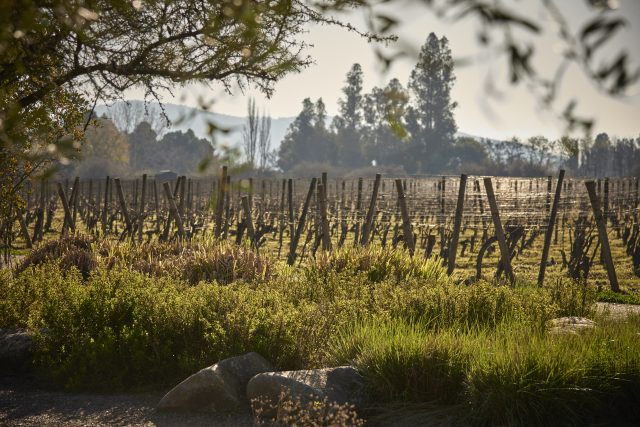
How to make a master
Below, db spoke to marketing director at Maquis, Laura Leiva, who provided some more detail on the specific attributes which made the Gran Reserva Cabernet Sauvignon into a Master wine.
Q: Maquis mentions sustainability and biodiversity at the heart of its operation in relation to the wine. How do you use geothermal energy in the vineyard? You also reference ‘minimal intervention’, could you go into a bit more detail about these elements?
A: The geothermal energy we use is for elaborating our wines at the cellar in a more efficient and eco-friendlier way. This innovative project of using geothermal energy at Maquis winery was born looking to reduce our carbon footprint with this technology, which consists in transmitting cold and heat to the cellar from a deep well with a heat pump that is much more efficient than heating with gas and cooling with a chiller for the fermentations.
This geothermal system also has the ability to transmit energy simultaneously in the cellar without using this heat pump and being even more efficient. Maquis winery was the first and until today the only Chilean winery using this energy for producing its wines.
Minimal intervention is the reflection of one of the main pillars of Maquis. The sustainability that had been worked since the early years, respecting and enhancing nature in a very special and unique terroir that is surrounded by two rivers. The vineyards are in complete balance with their environment where the biological corridors designed for enhancing the biodiversity and life in the vineyards are the key to work the ecosystem in perfect harmony where you do not have any pest pressures to manage.
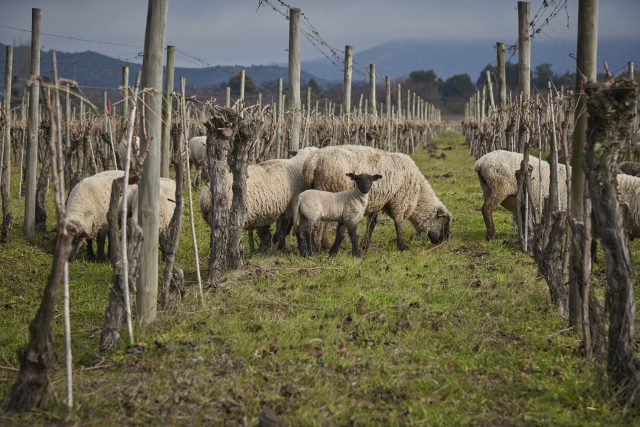
Q: Could you talk more about your biodiversity and biological corridors, as well as how sheep and chickens are involved in the vineyard. Also, could you provide some seasonal detail of how do you care for the vines?
A: At Maquis, we discovered a long time ago that the biological corridors contribute to having more complexity in our wines and that is why we decided to reinforce them by bringing more courses of water from the surrounding rivers to the vineyards and creating more corridors with life.
A biological corridor combines various different types of plants that provide food to many animals, insects, and other wildlife, and also where a proper refuge is provided for all of them. The biological corridors not only maintain life in the vineyards, but also attract new life, that reflects in a natural balance resulting in a final pureness of our wines that is very special and unique.
The use of sheep is also part of the sustainable management at the vineyards. It helps to control the weeds during winter and spring, where they actually live in the vineyards eating the weeds and sleeping between the vines in order to increase fertility in some spots where it is needed. The more recent project of preserving and using native chickens as pest controllers during spring had been very successful, specifically with the insects called “burritos” that attack the new buds of the vines and it happens to be their favourite food!
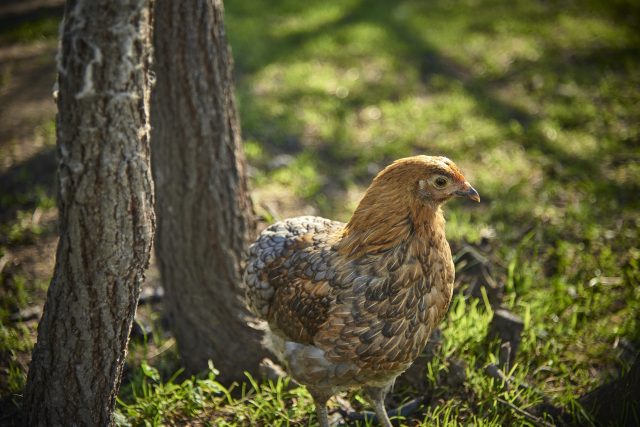
Q: Maquis makes reference to its old massal selections of Cabernet Franc, Carménère and Cabernet Sauvignon, planted on their own roots (ungrafted). Could you go into a bit more detail about the vines and their history?
A: The Maquis terroir has existed in this place with vines for three centuries. First, it belonged to the Jesuit order, then two ex-Chilean presidents had owned this place until 1916 when the Hurtado family acquired the Maquis vineyards.
Since then they worked for understanding this unique terroir, building an innovative concrete winery, as it was one of the first ones in Chile, constructed in 1927 by the first generation of the family, for then worked during the following years replanting own old massal selections of Cabernet Franc, Carmenere and Cabernet Sauvignon on their own roots (ungrafted) looking for more complexity and finesse in the final wines.
The selection for replanting with this heritage of vines led us to have been recognised, actually, with the world-class Cabernet Franc and Carmenere of Chile that are part of La Place in Bordeaux with Maquis Franco and Viola.
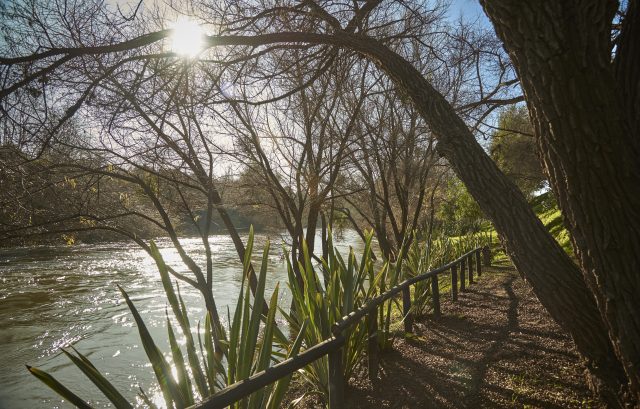
Q: In terms of the weather, could you go into some detail, specifically in relation to the Gran Reserva Cabernet Sauvignon which won the Masters, as to what made this year particularly special?
A: The unique terroir surrounded by two rivers give us very special conditions.
They have a much fresher climate than the rest of the Central Colchagua Valley, where Maquis is located. The cool breezes of the rivers cool down temperatures in summer and help to prevent frost damage during the spring. The soils also are very deep with clay and gravel that deliver perfect conditions for growing varieties such as the Cabernet Sauvignon, which was recently awarded with the Master Medal in The Global Cabernet Sauvignon Masters.
The cooler temperatures give us floral, fresh fruits and fine herbal aromas together with very elegant tannins, due to the amount of clay that irrigates slowly the available water in the soil for the growth of shoots with shorter internodes having more leaves that will collect more nutrients, having more concentrated and well balanced rich fruit for producing world-class wines.
The season 2020 was marked by a dry and warm climate. During spring maximum temperatures were higher than normal, although during harvest time they were completely normal. The minimum temperatures throughout the growth period were particularly higher than the last 10 years of measurements, which brought an early harvest compared to the previous season. This vintage is marked by an excellent intensity of colour, high concentration and complexity, and has a very good ageing potential.
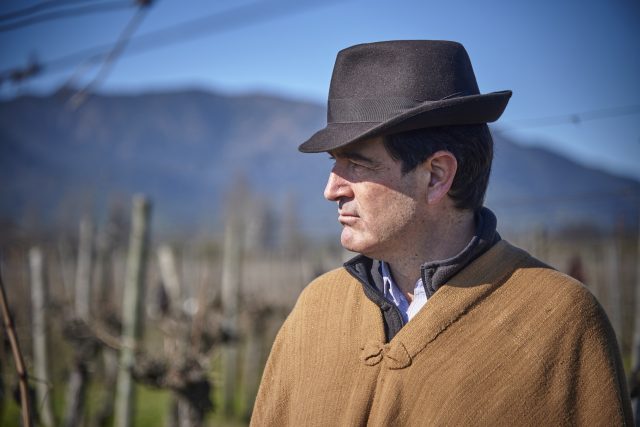
Q: Maquis talk about the skills of your viticulturist, Xavier Choné, and blenders, Jacques and Eric Boissenot, in making the wine. Could you go into a bit more detail about these skills and the application of them into the wine?
A: Ricardo Rivadeneira Hurtado, Executive Director of Maquis and third generation of the Hurtado’s family, met Jacques Boissenot when he started working at Maquis in 2000.
Later, in 2007, they started working together, with Jacques as master blender expert with the only red wine that we had at that time, Maquis Lien. Jacques was one of the legendary wine consultants of Bordeaux, covering the four of the five First Grows of Medoc, as well as other prestigious estates. He bought into the philosophy of the Maquis winery, and he advised on our final blendings since then.
In the following years, Jacques also pushed to bottle a separate Cabernet Franc from the rest of the blend, and Maquis Franco was born, and then a Carménère, bringing to life Maquis Viola. In 2014, when Jaques passed away, his son Eric continued working with us until today, creating the definition of our final wines for Maquis Lien, Viola and Franco, and continuing with the heritage of knowledge from his father.
Xavier Chone joined the team in 2005 for developing a new family project – Calcu – but his expertise is the focus on the vineyard architecture and actually director of “Terroir Wines & Vineyard” working as advisor for vineyards of some of the most prestigious winemaking brands in the world. He has been a key player in enhancing the existing terroir for each of our wines, actively participating in several visits round the year until now for supporting in decisions of harvest time, type of pruning, irrigation plans, and other work.
Maquis Gran Reserva Cabernet Sauvignon 2020

Here, judge of the Global Cabernet Sauvignon Masters and db editor-in-chief Patrick Schmitt MW provides his tasting notes on this Master winning wine.
“Some charred oak, toast, with dark fruit and a hint of jam. Palate full, fleshy, with sweet ripe fruit, nice red fruits here, mixed with the blackcurrant, toast and roasted coffee. Slightly chewy tannin, some stewed fruit, touch of maturity, ripe but not hot. Very good, and it’s hard not to drink. Fresh raspberry jam on the nose, dense immediately. Long, mouth-watering black & red cherry. Fresh, cedar notes give complexity and elegance. Deep, dark fruited. Oak spice with a hint of capsicum. Textured, creamy and of good concentration.”
It looks like you're in Asia, would you like to be redirected to the Drinks Business Asia edition?

